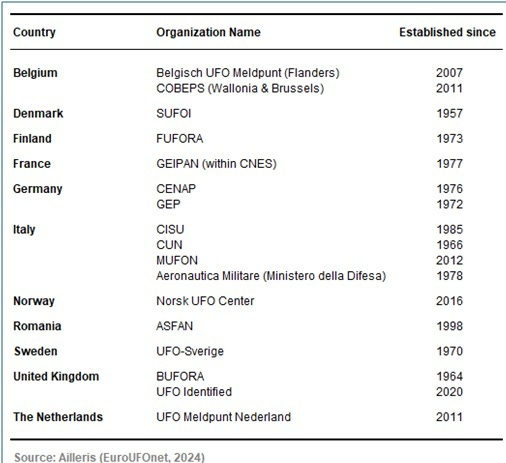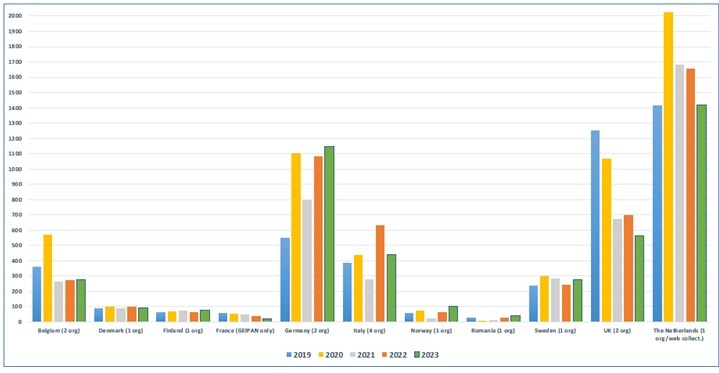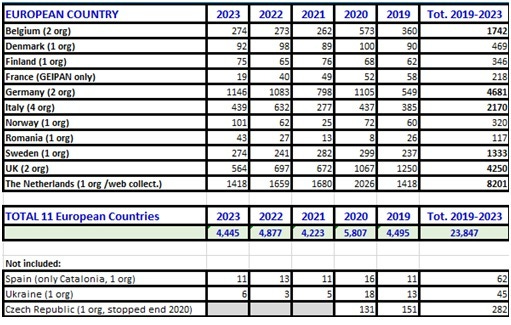Philippe Ailleris / European UAP Sightings in 2019-2023: Raw Data by Country and Year
The table and charts below represent the raw data of UFO/IFO observations reported to seventeen UAP organizations from eleven European countries where data are available.
THIS ARTICLE WAS PUBLISHED IN EUROUFO AND IS REPRODUCED HERE WITH PERMISSION, ALL RIGHTS RESERVED.
These raw data are provided thanks to the contributions of the following organisations listed in Table 1, which belong to the EURO UFO net virtual community, as well as national institutions like GEIPAN (France) and the Italian Air Force (Aeronautica Militare Italiana), which have published their statistics online.
TABLE 1
European UAP Organisations
These 11 nations account for approximately 69% of the European population and cover 49% of Europe’s land area (excluding Russia, Turkey). From a numerical standpoint, the dataset encompasses over 23,847 reported cases from 2019 to 2023.
Despite the incomplete nature of the data, which may not fully capture the total scope of sightings due to underreporting, it provides valuable insights into the frequency of UAP (identified or not) sightings across Europe over the past five years.
We hope that in the near future, other countries such as the Czech Republic (which ceased collecting data at the end of 2020 due to a lack of resources), Spain (currently the only active organisation is the CEI (Centre d’Estudis Interplanetaris) covers only a small portion of the territory (Catalonia)), Portugal, Greece, and Poland will be able to contribute to this valuable “UFO/IFO European Barometer.”
TABLE 2
Total Yearly Number of Reported Events
Overall, and somewhat unexpectedly, the number of reported events has remained quite stable over the period, totaling approximately 4,400 per year. The number of events in 2023 is comparable to those in 2019 (see Table 2).
However, there is a noticeable peak in 2020. One very likely reason for this increase could be the beginning of operational launches of the Starlink satellites by SpaceX, with 60 units launched at once. As noted in Table 3 below, the sharp increase in 2020 is attributed to three countries: Belgium, Germany, and the Netherlands. Overall, excluding this increase in 2020, the numbers remain relatively consistent globally across the 5 years period.
TABLE 3
Total Yearly Number of Reported Events per Country
In 2023, the number of recorded UFO cases varied significantly across different European countries.
The Netherlands reported the highest number with 1,418 cases, indicating a substantial level of sightings. However, it is important to note that the collection of reports in the Netherlands is exclusively done via the website of the only currently active organisation in this country. Additionally, the Netherlands has one of the highest population densities in Western Europe, with over 500 people per square kilometre. For comparison, Belgium has a density of 380 people per square kilometre, the United Kingdom 280, Germany 240, Italy 200, and France 120.
Germany followed with 1,146 cases, while the UK also saw a notable number of reports at 564. Italy and Belgium recorded 439 and 274 cases, respectively, showing considerable activity. Sweden matched Belgium with 274 cases, highlighting similar levels of sightings. Meanwhile, the number of cases in Denmark (92), Finland (75), and Norway (101) were lower but still significant. Romania reported 43 cases, while France, specifically through GEIPAN alone, recorded the lowest number with only 19 cases, the lowest since 2006. This figure should be interpreted cautiously, as it is unclear what precisely this online statistic includes or excludes; GEIPAN has acknowledged receiving numerous calls or emails that do not appear in their annual data. It is also noteworthy that in earlier years, when active civilian groups had robust reporting mechanisms, GEIPAN never received as many reports as these groups.
Overall, the distribution depicted in Table 3 indicates diverse levels of UFO activity and reporting mechanisms across Europe.
It is well-known among researchers across Europe that the vast majority of UFO cases are due to misidentifications of natural or man-made phenomena, such as Starlink satellites, the International Space Station, airplanes, and celestial bodies such as stars and planets. A separate analysis focusing on each country’s currently unexplained events from the past 5 to 10 years would be particularly valuable.
As can be seen in the above table, the UFO sightings across various European countries from 2019 to 2023 show significant fluctuations.
TABLE 4
Total Yearly Number of Reported Events per Country
TABLE 5
Annual Variations (Country/Year)
In 2023, Belgium maintained a steady number of reports with no change from 2022, but experienced notable variability in previous years, including a 54% decrease in 2021 followed by a 59% increase in 2020.
Denmark saw a slight decrease of 6% in 2023, continuing a trend of mixed fluctuations with an overall 10% decrease since 2018.
Finland, despite a 15% increase in 2023, shows an overall decline of 18% since 2018.
France (GEIPAN) recorded a substantial 53% decrease in 2023, marking a continuous decline to 61% below 2018 levels. It’s important to note that many observations made by French citizens are not reflected in the GEIPAN statistics. It would be interesting to know the average number of calls and inquiries GEIPAN handles via phone, letter, or email.
Germany exhibited a 6% rise in 2023, contributing to a significant 108% increase since 2018, reflecting a stark contrast to other countries.
Italy’s reports dropped by 31% in 2023 after a dramatic 128% rise in 2022.
Norway had a notable 63% increase in 2023, indicating a 60% rise since 2018.
Romania experienced a 59% increase in 2023, maintaining a general upward trend with a 34% increase since 2018.
Sweden’s sightings rose by 14% in 2023 but remained relatively stable over the five-year period, with only a 1% increase since 2018.
The United Kingdom saw a 19% decrease in 2023, aligning with an overall 19% decline since 2018.
The Netherlands reported a 15% decrease in 2023, yet still showing a 49% increase since 2018.
Overall, the total number of UFO sightings across these 11 European countries decreased by 9% in 2023 from the previous year, but has increased by 30% compared to 2018, indicating a complex pattern of reporting trends across the region.
Certainly, the majority of observers lack the experience to accurately interpret the sky and distinguish between natural and man-made phenomena. This makes it challenging for researchers to isolate genuine anomalies and dedicate their limited resources to the most complex cases.
In conclusion, it is also important to recognise the significant role played by non-governmental organisations and civil society. These long-standing national groups, spread across Europe, play a crucial role in serving the public. By providing a platform for UAP witnesses to share their testimonies and inquiries, they offer citizens a vital avenue to have their voices heard and their experiences acknowledged. Their activities range from testimonies collection, field investigation, analysis, documentation and archiving, support to study and research, as well as public education. The UAP groups exemplify citizen science applied to the UAP data.
Through this collective effort, these organisations maintain a comprehensive understanding of the UAP landscape at the European level and bring a wealth of experience to the field. Hopefully, more European countries will assume this role, either through official channels or with civilian groups, and expand their UAP research activities in the future, thereby enhancing our collective knowledge and investigative capabilities.










